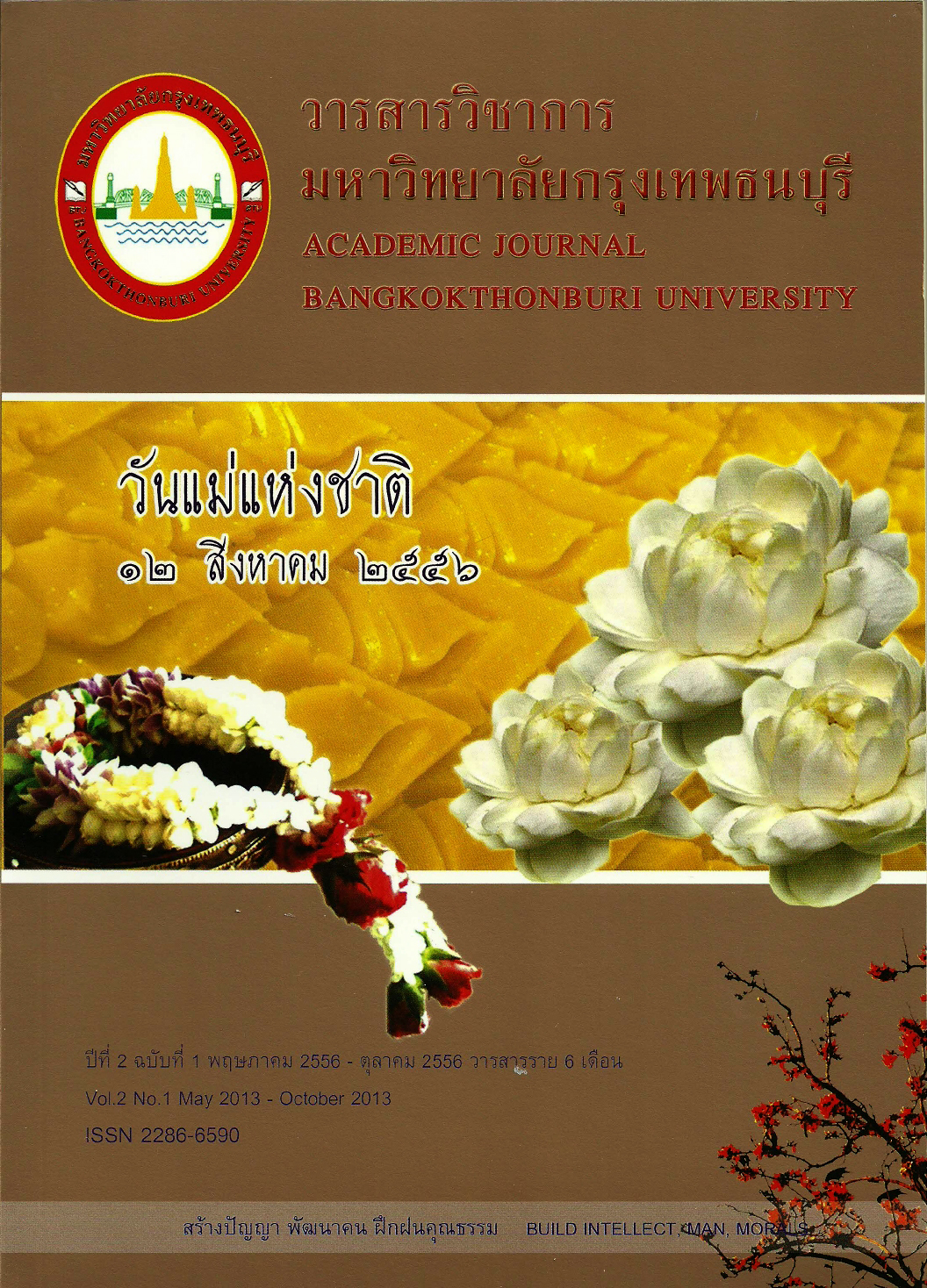แบบจำลองปรับขยายปัจจัยที่มีอิทธิพลต่อการเป็นองค์การ แห่งการเรียนรู้ของโรงเรียนมัธยมศึกษาภาคใต้
Main Article Content
Abstract
การวิจัยครั้งนี้มีวัตถุประสงค์ เพื่อศึกษาระดับการเป็นองค์การแห่งการเรียนรู้ของโรงเรียนมัธยมศึกษา ภาคใต้ และเพื่อพัฒนาแบบจำลองปัจจัยที่มีอิทธิพลต่อการเป็นองค์การแห่งการเรียนรู้ของโรงเรียน มัธยมศึกษาภาคใต้ที่สามารถนำไปประยุกต์ใช้ในทางปฏิบัติ จากกลุ่มตัวอย่าง 78 โรงเรียนที่ได้มาจาก วิธีการสุ่มแบบหลายขั้นตอน ผู้ให้ข้อมูลเป็นผู้บริหารระดับนโยบายและครูที่เป็นผู้บริหารระดับปฏิบัติการ โรงเรียนละ 5 คน จำนวน 390 คน เครื่องมือที่ใช้ในการวิจัยครั้งนี้เป็นแบบสอบถาม วิเคราะห์ข้อมูล เพื่อตอบวัตถุประสงค์ดังกล่าวข้างต้นด้วยสถิติพื้นฐาน และการถดถอยพหุ (Multiple Regression Analysis) ด้วย Method Enter และ Method Stepwise Multiple Regression ที่ระดับนัยสำคัญทางสถิติ .05 ผลการวิจัยสรุปได้ ดังนี้
1. ระดับการเป็นองค์การแห่งการเรียนรู้ของโรงเรียนมัธยมศึกษาในภาคใต้ (ทั้งในภาพรวมหรือ จำแนกขนาดของโรงเรียน) อยู่ในระดับสูง ถึง สูงมาก และมีลักษณะเสถียรภาพ
2. โครงสร้างของการเป็นองค์การแห่งการเรียนรู้ของโรงเรียนมัธยมศึกษาภาคใต้ของโรงเรียน ทุกขนาด เริ่มต้นที่วิธีการผ่านมิติการคิดอย่างเป็นระบบไปสู่หลักการทางที่เป็นมิติการมีวิสัยทัศน์ร่วม ยกเว้น โรงเรียนขนาดใหญพิ่เศษมีโครงสร้างของการเป็นองค์การแห่งการเรียนรูที้่แตกต่างไปจากโรงเรียน ขนาดอื่นๆ กล่าวคือ โรงเรียนมัธยมศึกษาขนาดใหญ่พิเศษมีโครงสร้างที่เริ่มจากวิธีการในมิติแบบจำลอง ความคิดไปสู่หลักการในมิติการมีวิสัยทัศน์ร่วม
3. แบบจำลองปรับขยายที่พัฒนาได้ถึงแม้จะมีโครงสร้างของกลุ่มปัจจัยที่มีอิทธิพลต่อการ เป็นองค์การแห่งการเรียนรู้ในภาพรวม (Y) ของโรงเรียนมัธยมศึกษาภาคใต้ตามหลักวิชาการทั้ง 6 กลุ่ม ปัจจัย แต่จำนวนโครงสร้างของปัจจัยย่อยในกลุ่มปัจจัยทั้ง 6 ลดจากทั้งหมด 48 ปัจจัยย่อย เหลือเพียง 17 ปัจจัยย่อย แต่ประสิทธิภาพในการทำนายค่ายังใกล้เคียงกัน (84.10% และ 82.40%)
4. สมการแบบจำลองปรับขยายปัจจัยที่มีอิทธิพลต่อการเป็นองค์การแห่งการเรียนรู้ในภาพรวม (Y) ของโรงเรียนมัธยมศึกษาภาคใต้ ที่เรียงลำดับความสำคัญของปัจจัยทำนายค่าตามค่า beta-weight คือ
Ŷ=29.919*+5.541*X11-2.274*X17-2.498* X12+2.689*X25+2.244*X61+1.924*X44 (3.841) (0.609) (0.487) (0.638) (0.682) (0.516) (0.415) +2.431*X41+2.105*X26+2.125*X13+2.733*X37+1.852*X21-1.534*X58- (0.536) (0.660) (0.647) (0.667) (0.497) (0.494) 1.226*X31-1.219*X56+1.015*X48-.311*X67+1.197*X35 ; 100 R2=82.40% (0.447) (0.549) (0.529) (0.O97) (0.569)
Modifi ed Model Factors Infl uencing Southern Secondary Schools’ Being Learning Organization
This dissertation was designed to examine the level of being Learning Organization of Southern Secondary Schools and to develop a Modified Model Factors influencing Southern Secondary Schools’ being Learning Organization so that it would be possibly put into practice. The data were collected from 78 sample secondary schools, selected by the Multi-Staged Random Sampling technique. The informants comprised administrators at policy level and teachers who were administrators at performance level; 5 persons per school, totaling 390 persons. The research instrument was a questionnaire. The collected data were analyzed by using Basic Statistics and Multiple Regression Analysis consisting of Method Enter and Method Stepwise Multiple Regression at the .05 level of significance. The research findings were as follows:
1. The level of being Learning Organization of Southern Secondary Schools (as a whole or as classified by school size) ranged from high to very high levels with stability.
2. The structure of Learning Organization exhibited by Southern Secondary Schools were derived from Systems Thinking to Shared Vision except extra large schools which had a distinguished structure of Learning Organization from Mental Model to Shared Vision.
3. Even though the developed Modified Model Factors had the structure composed of factors influencing the Southern Secondary Schools’ being Learning Organization as a whole (Y) as determined by academic principles in all 6 factors, the structures of sub-factors of all 6 factors reduced from 48 to 17 sub-factors. However, it could reveal approximately efficient prediction (84.10% and 82.40%)
4. The equation of the developed Modified Model Factors influencing the Southern Secondary Schools’ being Learning Organization as a whole (Y) prioritizing the significance of prediction factors determined by beta-weight was as follows: Ŷ=29.919*+5.541*X11-2.274*X17-2.498* X12+2.689*X25+2.244*X61+1.924*X44 (3.841) (0.609) (0.487) (0.638) (0.682) (0.516) (0.415) +2.431*X41+2.105*X26+2.125*X13+2.733*X37+1.852*X21-1.534*X58- (0.536) (0.660) (0.647) (0.667) (0.497) (0.494) 1.226*X31-1.219*X56+1.015*X48-.311*X67+1.197*X35 ; 100 R2=82.40% (0.447) (0.549) (0.529) (0.O97) (0.569)


